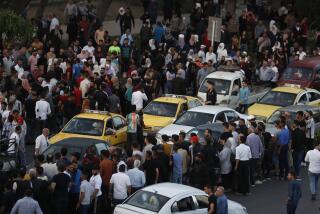Experts: Syrians can aid chemical weapons hunt with social media
The world learned of the Aug. 21 chemical weapons attacks in Syria from cellphone videos on YouTube, and coordinated use of social media would likewise help inspectors find, transport and disarm the Damascus government’s remaining poison gas stores, nonproliferation experts suggested Thursday.
Seven scholars at the James Martin Center for Nonproliferation Studies in Monterey have compiled a list of useful contributions that Syrian citizens can make in the proposed containment effort by sharing cellphone pictures, tweets about potential hazards and 3D modeling of suspected storage sites.
A Russian proposal to place the chemical weapons caches of Syrian President Bashar Assad under international control has been accepted by the Damascus government. Efforts are underway in the U.N. Security Council to launch an international search-and-destroy mission, which has at least temporarily delayed threatened U.S. airstrikes to punish Assad, suspected of using a nerve agent against his people.
At least 96% of Syria is covered by cellphone service and more than half of its 22 million people have a digital communications contract, the team of global nuclear, chemical and biological weapons experts noted.
“Syria’s chaotic civil war has caught large numbers of innocent civilians in the crossfire. One emerging tool these Syrians caught in the crossfire have to affect their situation are their phones,” observed the team headed by the center’s founding director and arms-control expert William C. Potter.
The report said average citizens armed with digital devices could assist in the effort to put Syrian chemical weapons under international control by:
-- Creating a crowd-sourced incident map showing the locations of blocked access and other harassment of foreign inspectors.
-- Mapping the location of hostilities near storage or production facilities due to be visited, to allow the inspectors to plot a safe route to their destination.
-- Familiarizing inspectors with the location and layout of sites by providing exterior photographs of the buildings and any available interior schematics that can be used to produce three-dimensional visualizations with geo-spatial mapping tools.
-- Photographing and transmitting images of suspected chemical weapons facilities that locals believe the government may be hiding from the foreign oversight team.
-- Providing real-time reports of road hazards, traffic backups or gunfire along the routes out of Syria, in the event that the inspectors are called on to transport the seized chemical arms out of the country for demolition.
“Combined with virtual reality tools, inspectors can actually do mock inspections and walk-throughs before they land in Syria, and train for many different evasion techniques,” the center’s report said.
The social media reports need not be limited to Syrians’ helping the inspectors, it was noted. If the international oversight operation were to provide Syrian citizens with regular updates on how the inspection and containment effort is proceeding, that would reassure them that the goal of eliminating the weapons of mass destruction that threaten them is achievable.
“The big question, of course, is how much cooperation we can expect from Syria,” the report concluded. “The big surprise may be that, even if the Assad government is less than forthcoming, everyday Syrians may more than compensate.”
ALSO:
Egypt extends state of emergency for two months
American militant on ‘most-wanted’ list reportedly killed in Somalia
North Korea may be restarting a nuclear reactor, U.S. institute says
Twitter: @cjwilliamslat
More to Read
Sign up for Essential California
The most important California stories and recommendations in your inbox every morning.
You may occasionally receive promotional content from the Los Angeles Times.










